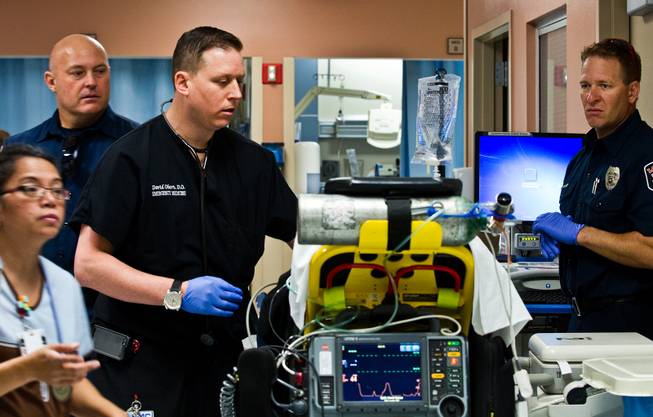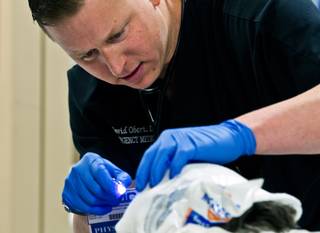
The emergency room at University Medical Center is typically a busy place, with attending physicians such as Dr. David Obert, center, doing their best to diagnose, treat and dispatch dozens of patients per shift.
Monday, June 29, 2015 | 2 a.m.
Tough love and medical care delivered daily
Most people hesitate to call an ambulance except in the most urgent of circumstances. Others call ambulances two or three times a week. Some Las Vegans use ambulances as taxis, to hitch free rides to destinations close to hospitals.
Two years ago, ambulance company AMR saw an influx of joyriders who called ambulances, provided false identification, then bolted when they arrived at the hospital. Even if paramedics know someone has insincere intentions, they aren’t allowed to turn patients away.
The abuse since has decreased — AMR officials aren’t sure why — but the problem of “frequent fliers,” people who regularly call 911, sometimes multiple times a week, to request an ambulance, continues.
When Stephanie Teague, a community paramedic specialist for AMR, visits patients’ homes, she drives a Ford Escape — not an ambulance. That’s the point. Many of the people Teague visits each week are former frequent fliers who called ambulances inappropriately because they let chronic conditions get out of hand, couldn’t secure a primary-care physician or needed a prescription refill.
Teague’s clients range in age from 22 to 75 and have chronic obstructive pulmonary disease, heart disease and diabetes, among other conditions. During home visits, Teague offers medical care and information to try to minimize unnecessary ambulance transports.
“What we’re really trying to do is give more to them than they can find on their own,” she said.
The patients’ problems vary. Some don’t have the right medical equipment or medications. Others are in financial trouble and need information about food banks and Medicaid. Teague visits twice a week at no cost to the patient.
The program, now 3 years old, reduces AMR’s costs and frees up ambulances and bed space in hospitals. AMR takes an average of more than 300 people to local hospitals daily, Teague said.
The 40 people Teague visits each month live across the valley and have become an important part of her life.
“It’s almost like being adopted into all these families,” Teague said. “Some of them need that mom-paramedic tough love. Other ones just need somebody to say, ‘I’m still here for you.’”
It’s Friday the 13th, and Dr. David Obert is driving to work. The date doesn’t worry him. As an emergency room physician at University Medical Center, Las Vegas’ public hospital, he can see crazy any day.
He calms drunk and delirious people and has stitched multiple gunshot wounds closed. He helped deliver a baby in the front seat of a truck. And, more than once, he has removed foreign objects that people willingly inserted into their bodies.
“There tends to be a lot of drugs (involved) with these things,” Obert said of the object removals. “I don’t even ask anymore.”
Obert, assistant medical director of the emergency medicine department, tries to predict the intensity of his day by scanning the highway billboards that list wait times at other local emergency rooms. Thirty-nine minutes. That alarms Obert because it’s almost a guarantee patients will clog his lobby. If it’s busy at other local hospitals, UMC’s emergency department is almost certain to be slammed.
As the city’s safety net for the poor and uninsured, UMC’s emergency department has no shortage of action or variety. Last year, nearly 75,000 adults received care there, along with more than 31,000 children and almost 12,000 trauma victims. UMC has separate trauma, adult and pediatric emergency rooms.
About 17 percent of the patients had no health insurance, although that’s down from a peak of 36 percent before the Affordable Care Act went into effect.
Obert has worked at UMC for nine years. It’s the type of atmosphere he sought after volunteering as a college student at a tiny community hospital in California. On his first day there, a man with a stab wound arrived at the emergency room.
“I was hooked,” Obert recalled.
•••
At 6 a.m., a man complaining of chest pain walks into the emergency room. He has suffered a heart attack before. The Veterans Affairs Hospital in North Las Vegas sent him here, figuring UMC would be better equipped to handle his needs.
UMC operates Southern Nevada’s only Level 1 trauma center and the state’s only burn center. As such, it’s often the landing place for people with life-threatening gunshot wounds, motorists involved in car wrecks, people who attempted suicide and others barely clinging to life.
“It’s a catchall,” Obert said. “It’s truly the fail-safe, the backup. A lot of stuff ends up here by default.”
The emergency room receives the lion’s share of those cases. People flock to UMC’s emergency department for a variety of reasons — such as having no health insurance or having difficulty securing an appointment with a primary-care doctor. Many patients see the emergency room as convenient, a place to fill prescriptions, get a hot meal, sleep in a warm bed. The department doesn’t turn away anyone.
For years, UMC has struggled to keep afloat financially. Clark County taxpayers bailed out the hospital with a $71 million subsidy in 2014. At the same time, hospital officials eliminated 390 positions and closed four satellite clinics.
The valley’s doctor shortage puts an extra squeeze on the emergency room, as does the community’s lack of resources for the mentally ill. About 20 percent of patients in UMC’s emergency room show signs of mental illness.
Patients arrive by ambulance, public bus and car, most often with abdominal pain, chest pain or respiratory issues. The majority of patients — 53 percent — aren’t severely ill, hospital officials said, despite the fact that emergency rooms were created to serve only the most urgent health emergencies.
•••
At first, the 33-year-old woman’s symptoms point to anxiety: She suffers extreme headaches when she lies down after long days juggling work and caring for her four children.
But as the woman tearfully explains a list of other symptoms — dizziness, nausea, a change in her hair texture — Obert begins thinking otherwise. He’s sitting next to her because it’s less intimidating, and he needs her to feel comfortable enough to share everything. He also summoned the help of a Spanish translator, a frequent necessity given the hospital’s large number of Hispanic patients.
“You look tired to me,” Obert tells the woman as he examines her neck. “We’re going to check a few things.”
He orders a blood test to test for a thyroid disorder. Several hours later, the results indicate Obert’s hunch was correct: The woman’s hormone levels indicate hyperthyroidism. Obert starts her on medications, and the woman and her husband leave the hospital.
In the meantime, Obert has spoken with numerous other patients, including a 25-year-old with a severe case of strep throat, another man with chest pain, two jail inmates and an elderly woman who fell, gashing her left eye and breaking her shoulder. Another patient complaining of stomach pain arrived by ambulance but left shortly after paramedics wheeled him into the emergency room.
“It happens on a regular basis,” Obert said. “It’s unfortunate for him if he really does have a medical problem.”
By the end of Obert’s eight-hour shift, he has seen 20 patients and mentored several medical residents. UMC is a teaching hospital, and training the next generation of doctors is a big part of Obert’s job.
•••
A man who was found ebbing in and out of consciousness at a bus stop wakes from his daze when Obert visits him. The man is confused.
“Do you know where you’re at?” Obert asks.
The man doesn’t respond, so Obert helps him: “This is a hospital. Do you know what city you’re in?”
“This is Los Angeles, Calif.,” the patient says.
Obert poses more questions, trying to piece together what happened. Soon, the man’s memory becomes less fuzzy. He remembers being at a casino with a flask of Fireball whiskey, playing blackjack. He was winning. But somehow he got kicked out, so he headed toward the bus station. He may have taken a few Xanax pills too.
Obert advises him to cut back on the alcohol and refrain from mixing it with drugs.
Once the man gets in touch with family who can pick him up, he’s free to leave. He didn’t suffer any injuries.
Obert said he receives a fair share of patients whose medical problems are related to alcohol, drugs, gambling or sex.
“People will hop on a bus and be like, ‘I’m going to Vegas,’” Obert said. “Then they get here and have no social support.”
That paves the way for bad things to happen and for UMC to welcome more patients.


Join the Discussion:
Check this out for a full explanation of our conversion to the LiveFyre commenting system and instructions on how to sign up for an account.
Full comments policy